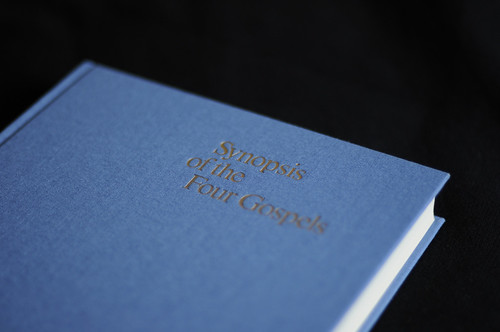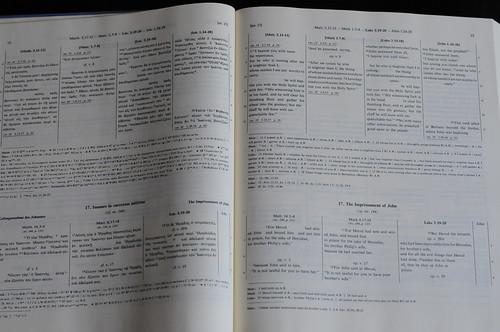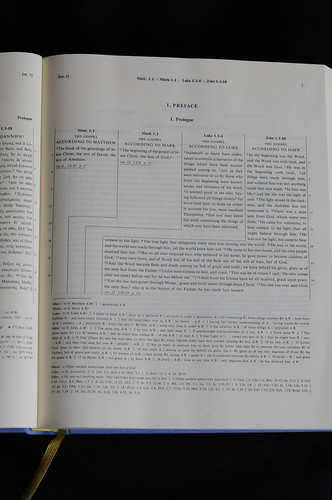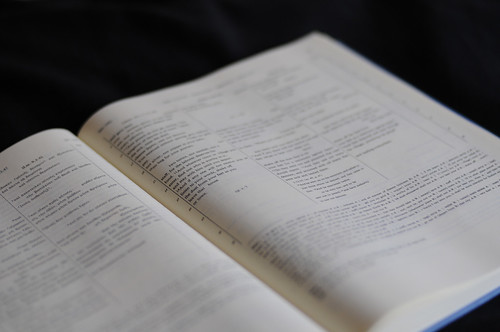Synopsis of the Four Gospels
The Bible itself is a complicated design project, so imagine how challenging it is to arrange Greek and English parallels in a synopsis of the Gospels. Jesus Saenz found out firsthand when he picked up a copy of Kurt Aland's beautifully produced Synopsis of the Four Gospels, and he was gracious enough to take some photos to share. The write-up is fascinating -- especially the conclusion. Some books don't need the goatskin treatment; they're perfectly fine how they are. Jesus says:
Several months ago I had read of a book that contained the four Gospels arranged vertically. That is, rather than reading the Gospels one at a time, it contained the parallel passages of the Gospels next to each other. As a study aid I thought it was a fantastic idea.
As I looked into it, there were three editions available. One had the parallel passages in English, using the Revised Standard Version, the other was in Greek and this edition which has the Greek and English on facing pages. The book itself is large measuring 10.75” x 8.5” x 1.1”. It is hardbound in a light blue cotton linen cover that is reminiscent of textbooks or school library books from my youth. The title on the spine is wonderfully placed, stamped in gold, the cover has the title as well.
The inside is just as appealing as the outside. The pages are a cream color and as smooth as a John Coltrane solo. The paper feels less like wood pulp and more like cotton. The print is dark, making a nice contrast with the page color. The print is even from page to page, beginning to end. I only wish that all of the Bible publishers would take the same care with their printings.
This large tome is not for casual reading but for the serious study of the Word. The binding is sewn, that and the size alone make it lay flat wherever the book is opened to. Another reason this is not a book you just sit with breeze right through is that is contains the full apparatus of the Greek New Testament and all of its variants as well as the variants in the English. There is a wealth of knowledge in this book.
As part of the introduction, there is a list of all the manuscripts as well as the date of the manuscript and it’s current location. The apparatus shows the variants from any manuscript, the source manuscripts, either the Majority, Sinaiticus, Byzantine, etc., or if it came from a lectionary or from an Early Church Father. The introduction has a list of all the papyrus codices, uncials, minuscules and the contents of the codices as not all the early manuscripts had a complete New Testament. It is a treat to be able to try and trace the transmission of the New Testament through these codices.
This is a major help for anyone who is a teacher of the Word. The pericopes are laid out with a heading then divided by lines per Gospel writer. The chapter and verses for each are included per pericope and left empty if one or more of the Gospels do not have a parallel. The English variants include those from the RSV, AV, RV and the ASV. You can easily see all the parallel passages without having to turn from gospel to gospel as they are laid out neatly. You can now see how each writer describes common events such as the crucifixion. The style of the individual writer can be seen a little more clearly, especially if you read Greek.
Before receiving this book, I was considering it as a candidate to be rebound but upon further inspection there is no way I would send this book to be rebound. It is a magnificent book, all on it’s own. Even if the covers aren’t floppy or made from a dead animal.
-- Jesus Saenz
Thanks, Jesus, for sharing this interesting volume with us. I think the page design illustrates just how clever a designer of reference works needs to be in order for the material to "make sense" visually. And I agree completely: there's no need for a rebind. A beautifully-produced hardback is a pleasure to use.
By the way, if you'd like to see more photos, Jesus has set up a Flickr Set with nineteen images, including the five shown here. It's worth checking out!





